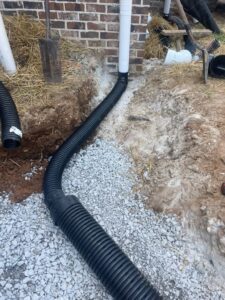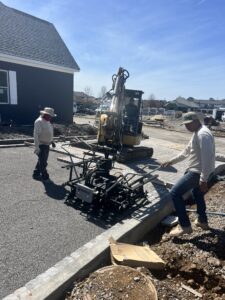April showers may bring May flowers—but they can also bring soggy yards, washed-out mulch, and even foundation issues if your drainage isn’t up to par.
We’ve been hearing it more and more from homeowners across Middle Tennessee:
“In the past 10 years, this area never flooded. Now it’s happening regularly.”
They’re not wrong—the data backs it up.
Why Drainage Issues Are Getting Worse
Tennessee’s weather is shifting.
We used to see slow, steady rain. Now we’re seeing more frequent storms dropping 2 inches of rain in just 24 hours. Nashville’s annual rainfall has also gone up significantly—climbing from a historical average of 47 inches to nearly 52 inches in recent years.
Even the Tennessee Emergency Management Agency has warned about “excessive rainfall and flooding threats” due to multiple rounds of storms saturating the ground, in February 2025.
And it’s not just us. Nationally, 126 U.S. cities are seeing stronger rainfall events, with an average increase of 15% in hourly rainfall intensity since 1970.
Even city planners are taking note. Old standards based on 100-year flood maps no longer hold up—the storms we see today are actually rewriting the rules.
How to Know If You Have a Drainage Problem
After a rainstorm, take a slow walk around your yard and pay attention to what you see—and even smell. Is water pooling in the same low spots every time? Do your downspouts dump water just a foot or two from your foundation? Soggy grass that never fully dries, even days after the rain, is another red flag.
You might also notice more subtle clues: mulch being washed out of beds, splash marks on your siding, or a musty smell near your crawlspace. Mold and mildew often follow standing water. In your landscape beds, yellowing leaves or struggling plants may also be a sign of trouble—especially if your soil feels consistently wet.
Not sure if the issue is with your irrigation or drainage system? Our blog on irrigation warning signs can help.
Problems Caused by Poor Drainage
Drainage problems don’t just make your yard a muddy mess. They can affect everything from your landscaping to your home’s structure. Here’s what to watch out for:
Plant and Lawn Health Issues
- Root Rot – Plants suffocate when water lingers around the roots too long, causing decay and stunted growth.
- Fungal Lawn Diseases – Wet conditions trigger things like brown patch and dollar spot.
- Yellowing or Wilting Plants – Oversaturated roots can’t absorb nutrients properly.
- Soil Compaction – Constant moisture can compact soil, limiting root growth.
- Pests – Mosquitoes, fungus gnats, and slugs love soggy conditions—and moles do too.
Structural and Property Damage
- Foundation Cracks and Settling – Water pressure can damage the foundation over time.
- Basement Flooding – Poor drainage is one of the most common causes of water in basements.
- Erosion – Valuable topsoil, plantings, and mulch can be washed away.
- Driveway or Patio Damage – Freeze-thaw cycles in wet areas can crack or shift hardscapes.
- Wood Rot and Mold – Constant moisture near siding, decks, or posts leads to decay.
Not all plants can handle our changing weather conditions either. If you’re curious which ones to avoid, we covered that here.
Fixing It: Smart Drainage Solutions That Work
At Puryear Farms, we offer drainage systems tailored to our Tennessee weather and soils. Here’s a breakdown of the most effective options—and when to use (or avoid) them:
Gutter Line Extensions
Extending your downspouts away from the home helps direct roof runoff into the yard, preventing it from pooling around your foundation or porch. This is ideal for homes where water consistently splashes or puddles near the base of the house.
Not ideal if the yard has poor grading or nowhere for the water to go—it could just move the problem further out unless paired with other solutions like French drains or swales.

Foundation and French Drains
A French drain is a gravel-filled trench with a perforated pipe that collects and redirects water underground. It’s perfect for areas with recurring soggy spots, along retaining walls, or around foundations that are seeing water seepage or basement leaks.
Not the best choice if you have shallow bedrock, extremely compacted clay soil, or minimal slope—conditions where water can’t flow freely through the system.
Surface Drain Rerouting and Catch Basins
Catch basins are in-ground drains that collect surface water and channel it away through buried pipes. These are great for redirecting water from patios, driveways, or compacted lawn areas where water pools quickly.
Not a fit if your problem is deep subsurface saturation—this solution addresses surface runoff, not underground drainage.
Permeable Pavers
These specialized pavers allow water to seep through gaps filled with gravel or sand, reducing runoff and encouraging groundwater recharge. Ideal for walkways, driveways, or patios where you want both beauty and functionality.
Not suitable for steep slopes, heavy clay soils, or areas that already have drainage issues beneath the surface—it won’t fix an existing problem underground.

Dry Creek Beds for Swales
Dry creek beds are decorative, rock-lined channels that help manage runoff in large swales or sloped areas. They slow down the flow of water, reduce erosion, and double as a landscape feature.
Not recommended for small, flat yards or areas without natural runoff paths—they require room and a proper grade to function as intended.
Spring Is the Time to Act
Before summer storms arrive, now is the perfect time to:
- Extend or repair your gutter lines
- Clear clogs and check for damaged pipes
- Diagnose wet spots and splash zones near the foundation
- Prevent costly damage with long-term drainage planning
Even a small fix now can prevent major issues later.
Let’s Get That Water Moving
Protect your home, your yard, and your peace of mind.
Call today or visit us at www.puryearfarms.com to schedule your consultation.
